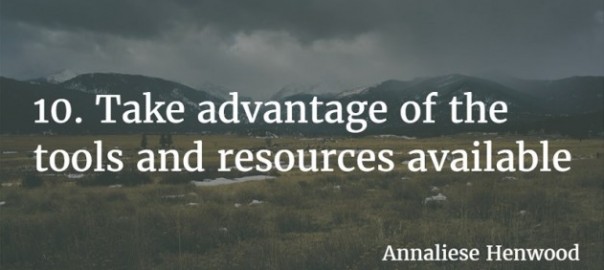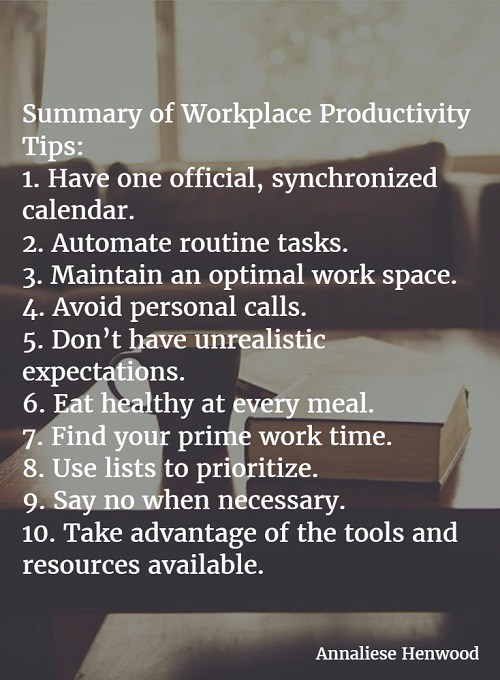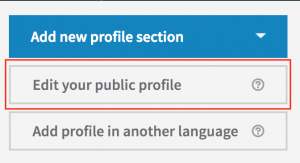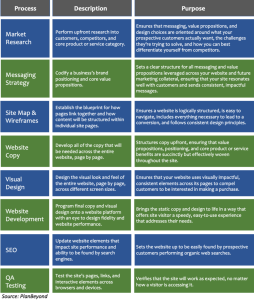Do you doubt the need for more workplace productivity tips?
Are you wondering how someone else’s advice can apply to your own experiences?

You may be thinking: “Why read yet another article about productivity?”
Allow me to answer that for you…
We all struggle to stay productive through the whole day and week at work. Times can be slow or overwhelming, and it can impact our productivity in the wrong ways. You can check these productivity articles to see if they offer practical advice you can apply to your own environment. If the article is simply a list with a description, that’s not enough. You need to know how to get started with that tip.
Whenever you see an article like this one, you get that author’s own take on what productivity advice to try for yourself. It may be that those tips worked for said author, but it could also mean those tips are popular and even proven effective for many other people as well.
In my article, I don’t just list the tips and move on. I give you the reasons for why the advice is worth a try and how you can apply it. I give you the resources to get started with each tip. It makes for a longer article, but that’s what it takes to give you the most applicable advice.
Don’t want to read more than the tips themselves? Allow me to be unconventional and provide my summary at the beginning of the article for a change. If you want to know more about each tip, simply continue scrolling. If not, so be it, but you’ll be missing out.
Summary of workplace productivity tips:
- Have one official, synchronized calendar.
- Automate routine tasks.
- Maintain an optimal work space.
- Avoid personal calls.
- Don’t have unrealistic expectations.
- Eat healthy at every meal.
- Find your prime work time.
- Use lists to prioritize.
- Say no when necessary.
- Take advantage of the tools and resources available to you.
Do these seem appealing to you? Read on to see how you can apply these tips to your own work environment.
1) Have one official, synchronized calendar

Why have only one calendar?
Oftentimes, we can use a computer program as our home base for our calendar, but when on the move, we resort to paper planners or mobile apps to record new items. If we don’t synchronize our different calendars to our home base program, we risk missing an important meeting, deadline, or other key item.
It’s difficult to keep track of everything when our calendar is scattered onto multiple platforms. It’s a risk you don’t have to take.
How do I maintain one calendar when I’m constantly on the move?
It’s inevitable that you’ll need to record a new calendar item while you’re away from your computer. My recommendations:
- Use a mobile app that allows for real-time synchronization with your main calendar.
- Use a paper planner, but add each new item to your main calendar as soon as possible. Set a time every day to add new items to your calendar. Time-sensitive records should be marked for importance if they can’t be added in time.
- Connect your different services, such as Outlook and Google Calendar, to have everything visible in one place.
What tools can I use to maintain one calendar while on the go?
You can find so many iPhone and Android apps to help you keep your calendar items in sync.
If you want to find the best one for your needs, your best bet is to experiment, starting with the free ones. You don’t want to buy something when there are free versions out there that can be just as effective.
This is the tool I’ve used for maintaining a calendar system. It works for me and may work for you as well.
- 24me Smart Personal Assistant – iOS only
“One place for all your calendars, tasks, notes and personal accounts”
Price: Free
2) Automate routine tasks

Why use automation for productivity?
Tedious, routine tasks can get in the way of your more important responsibilities. For example, if you have a major project deadline coming up, manually scheduling your social media activity can interfere with your work.
You can manage some tasks very easily by automating them instead of doing it manually. This leaves ample time for you to focus your attention on other tasks.
How do I automate tasks / what tools can I use?
While it depends on what you want to automate, there is one leading service that seems to do it all: IFTTT.
With IFTTT, you can create formulas to connect one account with another. Here is an example:

You can choose from a large selection of existing formulas or create your own.
These are just a few of the account options you can choose from. In this case, I focus on social media reporting:
- I think it’s safe to say almost all major social networks are represented.
- Bitly
- Buffer
- Dropbox / Google Drive
With Dropbox and Google Drive, you can create files that are automatically refreshed to include metrics and other information, such as new followers or relevant tweets based on an assigned category.
It’s a very handy program.
With social media scheduling, Buffer offers services to help you share content easier without all the manual work.
These are just a couple of the many ways you can automate routine tasks. Give them a try if they apply to you, and experiment with IFTTT yourself to see if it can help you.
3) Maintain an optimal work space

Why is my work space important for productivity?
You spend approximately 8 hours a day at your desk Monday – Friday. It’s absolutely essential that this space be optimized for concentration and health.
If your work space is messy, it becomes hard to work. You can get distracted and have trouble finding things. Disorganized work spaces can bring your productivity down.
How can I improve my work space?
To start, keep it clean. You need to have plenty of open space on your desk.
- Keep your files organized in folders and drawers.
- Have your supplies collected and located in one place.
After you’ve cleaned and organized your desk, focus your attention on making your work space ideal for concentration:
- Use plants for fresh oxygen and aromas.
- Use natural sunlight for mood and alertness.
You also need to pay attention to your physical health when working so much at your desk. This means making your equipment ergonomic:
- Buy an ergonomic office chair.
- Invest in a standing desk or elevation equipment for on your existing desk.
- Buy the right padding for your mouse pad and keyboard.
Once you have these things set up, you’re on your way to increased productivity.
4) Avoid personal calls

Why shouldn’t I answer calls from family and friends?
By answering personal calls during the workday, you not only distract yourself from your tasks at hand. You cause delays.
When you answer a personal call, especially when it’s a long call, you lose your focus. This, in turn, delays your progress on that task.
What can I do to avoid these personal calls?
Sometimes, these personal calls are important, so I recommend having an assigned time during the day to respond to any personal calls you skipped. Your lunch break or midafternoon are ideal.
Otherwise, block calls from ringing or appearing on your phone, or notify your family and friends that you can’t talk during the day.
How do I prevent these calls from distracting me?
With a smartphone, you have the option to either silence your phone or turn on a Do Not Disturb feature.
Do you use your cell phone for work? Change the ringtone for friends and family so that you know when to ignore the call.
5) Don’t have unrealistic expectations

What are considered “unrealistic expectations?”
When I say that, I refer to the quest for perfection. If you spend all your time and effort trying to be perfect, you can end up burning out. Your work can suffer as a result, leading to the opposite of what you sought.
You don’t want to seek the impossible when you work on a task because you’ll burn out and get frustrated.
How do I avoid this attitude?
Don’t seek perfection but rather be complete. Create work with high-quality in mind. Make sure you’re accurate, but don’t worry about whether you could do even better. As long as you do the work to the best of your ability, focus on that.
When your work is done, learn from any mistakes. You’ll always have more to learn, so don’t feel disappointed if you receive criticism. Simply grow with each lesson.
6) Eat healthy at every meal

What’s so important about eating healthy every time?
I know it is definitely hard to eat right, especially at lunchtime when we’re busy. I know I’d prefer to have something quick and easy to eat, and that’s not often the healthiest approach.
- If you don’t eat healthy for breakfast, the weight of all that junk food can prevent you from focusing and getting things done efficiently.
- If you don’t eat healthy for lunch, be ready for a long afternoon of food-induced exhaustion. Be prepared to drink excess caffeine to stay awake.
- Dinner isn’t directly relevant to work, but while we’re speaking about eating healthy, you might as well be healthy then too.
How do I eat healthy when work can get in the way?
A quick solution: prepare your lunch the night before, such as a salad or sandwich. Have all the ingredients ready to go. The only thing you need to do is remember to bring your food to work the next day.
A more in-depth solution: stay away from those fast food options by either partnering with a coworker for peer support or developing a goal for why you should eat right.
7) Find your prime work time

How does focusing on a specific time period help me?
There are times of the day when we’re at our worst. We’re tired and slow-moving. Oftentimes, this time period is when we’re just about ready to go home for the day.
There are also times when we’re at our best. We’re alert and productive. Oftentimes, this time period is when we’ve had our coffee and are settled in at work mid-morning.
However, we all have our preferences in when we work at our best. I am best first thing in the morning, but you could prefer mid-afternoon.
The point is: you want to use this prime work time to its fullest for the best efficiency possible.
What should I do when I know my prime work time?
This is when it’s most important to avoid those pesky distractions. It’s the most important time to be fully focused on what’s most important.
- Select the tasks that have approaching deadlines or are most extensive.
- Focus on the tasks that require the most concentration.
- Do not spend the time on those routine tasks I discussed earlier.
- Do not spend the time on any tasks with low priority.
- Use apps and website blockers to prevent calls, social media, or email distractions.
Your prime work time is the most important period of your day, so use it to its greatest potential.
8) Use lists to prioritize

What do lists accomplish?
I know some of you might have alternate ideas to this approach, but work with me here.
Unless you can remember everything without writing it down, using lists can really help:
- Helps you remember deadlines
- Helps you visualize which tasks are more important than the others
Use lists for organizing your tasks so that you can prioritize each one and get them done in the most efficient order possible.
How do I create these priority lists?
When you write down everything you have to do, it can look overwhelming, so stick to one day at a time if you can. If you’re using an app or a program, stick to the “today” view if that’s an option.
Color-coding your tasks is a great way to quickly see which tasks are more urgent than the rest. You can do this with paper and markers or create categories/labels in an app or other service.
Use an app or program to help you visualize, such as:
Great for task management and to-do lists, and you can use it pretty much anywhere
Cost: Free for basic, $ 28.99/yr for premium
9) Say no when necessary

Why would I say no to a new task, especially from a superior?
Good managers should know that bombarding someone with tasks can lower the quality of the work and prevent some of them from getting done in time.
If you’re currently swamped with work, you need to say no to any further responsibilities. This way, you allow yourself the ability to focus on what you already need to do.
Being overwhelmed with work can prompt you to multitask, or at least try to do so. Multitasking works at times, but it’s a risk to the accuracy and quality of your final product.
How do I say no when my boss has asked me to do something else?
The best approach is to stay solution-based. Instead of bringing up the problem with your boss’s new task, explain how you can handle it without actually saying yes.
In other words, take a look at this scenario:
I have 5 major projects due this month along with my routine social media and reporting responsibilities. I’m swamped.
My boss approaches me with a 6th major project with an incredibly close deadline.
I explain to my boss what I’m currently working on, informing him of my progress with each one. I then make a recommendation for how to get the 6th project done in time:
- Does the 6th project have higher priority than any of the other 5?
- Can a coworker assist me with any of the 6 projects to ease the workload?
- Would it be possible to pause a routine task to make room for the new project?
My boss chooses an option that works best for his needs.
I get everything done in time without sacrificing the quality of my work.
Give your superior a short list of possible solutions, and help him decide on what would work best for him and the company.
Instead of a blatant “no,” give him a valid reason why and a sound solution to that obstacle.
10) Take advantage of tools and resources

Why invest the time and other resources to extra tools?
We can’t always get things without certain assistance. Tools help us create the best products or results.
Tools can:
- Keep us organized
- Help us manage our time better
- Give us a platform for saving ideas for later
- Help us record notes in a way that can easily be applied elsewhere
How do I find the best tools for workplace productivity?
We all have our own ways of doing things, so there really isn’t one simple answer to this. My best recommendation is to create a checklist of features you’re looking for in a tool and follow that as you look around.
To get you started, these are just a few tools I’ve used and recommend:
Pomodoro Technique for time management
It tells you when to take breaks and records how long you’ve worked on a specific task.
Evernote for notetaking
It gives you a way to organize all your ideas and thoughts in one place.
Grammarly for proofreading
It checks your work for grammatical accuracy.
Pocket for content management
Use this to save articles to read / videos to watch later.
By now, you should have a much better idea of how to maximize efficiency with these 10 workplace productivity tips.
You now know:
- The importance of a single calendar
- How to automate routine tasks
- What you can do to maintain an optimal work space
- Why personal calls must wait
- How to be accurate without trying to be perfect
- The value of eating healthy
- Best practices for using your prime time
- How to prioritize your tasks with a list
- Why you need to learn to say no sometimes
- The advantages of extra tools
Find more workplace productivity tips in my other article:
10 Productivity Tips to Help You Work at Your Best
Do you know of any other productivity tips we can apply to the workplace? Let us know in a comment below!
Business & Finance Articles on Business 2 Community(138)
Report Post







